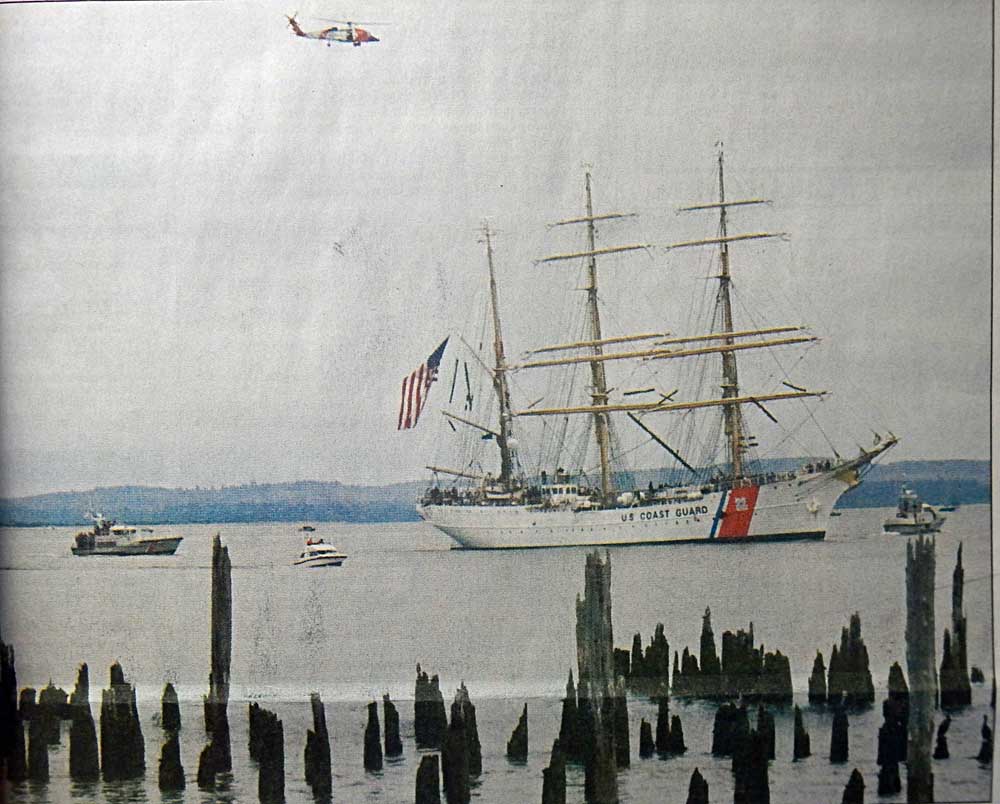Water under the bridge
Published 5:18 am Wednesday, June 13, 2018

- The Coast Guard cutter Eagle is escorted up the Columbia River into Astoria in 2008.
10 years ago this week — 2008
Senior class president Anthony Kustura stood before a standing-room-only crowd and addressed those gathered in the Astoria High School gym.
“It has been a long time coming,” he said, “and now our time is here.”
The Class of 2008 graduated Saturday afternoon, marking not only a bittersweet end of 139 students’ time in Astoria schools, but of a nearly decade-long series in The Daily Astorian tracking their progress.
The Daily Astorian undertook a major project in 1998 when it adopted the third-grade classes at John Jacob Astor Elementary, pledging to follow them through their high school graduation.
Few modern mariners can claim they’ve traveled the seas in a square-rigged tall ship.
But Coast Guard Lt. J.G. Ben Lee sailed across the Atlantic Ocean to visit seven European countries during his time on the cutter Eagle — not counting a tour of the Caribbean — as have many others training for maritime service on the stately barque.
While travel is a side benefit, life aboard the Eagle “is also a lot of hard work,” said Lee, who now works in engineering on the Astoria-based Coast Guard cutter Steadfast.
Even with sails furled, running on engine power, the ship was tough to miss Thursday as a Columbia River bar pilot steered her up the channel toward the 17th Street Pier, where the Eagle docked for four days of free public tours.
50 years ago — 1968
Descended from a lowly chicken feeder, a 50-inch bundle of energy called the Lektro forklift is rolling out of the assembly room at Wilt Paulson’s factory at Clatsop airport.
The bright orange and blue lifts, operated by power from a self-contained battery unit, are designed to pick up a 1,500-pound load, raise it to a height of 10 feet and hustle it around the floor of a small factory.
“It’s designed for the small businessman who can’t afford to spend $6,000 for a lift,” Paulson said.
The units are expected to sell in the $3,000 range.
Designed in the Lektro factory, the lift has been in production about two months. The basic power plant is patterned after one used by the firm in manufacture of a battery-operated chicken feeder. Lektro Inc. also makes a golf cart.
Paulson, president of the firm, recalled that the organization will be 21 years old Aug. 8 and for the past 21 years has specialized in battery-operated machines.
Port of Astoria commissioners agreed Tuesday night to a joint venture with Port of Portland to lease the former maritime administration reserve fleet base and convert it to some useful maritime purpose.
The maritime administration has given up the base, moving all the ships out to Suisun Bay and Olympia reserve fleet bases.
Full utilization of present fish hatchery facilities might triple future production of the silver salmon “farms.”
This fact was brought out Wednesday at a meeting of federal and state fishery officials with representatives of Astoria packing plants and the Columbia River Fishermen’s Protective Union.
75 years ago — 1943
One of the oldest dairy cooperatives in the west — the Skamokawa Farmers’ Creamery — has been absorbed by the Lower Columbia Dairy cooperative, which has completed negotiations for purchase and is awaiting WPB priorities to complete the deal, it was learned today.
The Skamokawa cooperative was organized in 1894 and at time of its purchase late last month had about 150 members. The company was manufacturing between 300,000 and 400,000 pounds of butter a year, with its byproducts from skimmed milk going largely to casein until recently.
McDannell Brown, chief enforcement attorney for the district office of price administration, said here in explanation of the current checking of cars at fishing streams and summer resorts, “No one has a moral right to do any pleasure driving at all.”
He added that the 90 miles of gasoline a month A, B, or C card holders are allowed for family driving is not for pleasure trips but for necessary errands. He said penalties for pleasure driving will be imposed by ration boards to the extent of revoking a gasoline ration entirely.
Two women employees at the Astoria airport really know now what it means to be taken for a ride. Better than the familiar ditty “I’m a specialist and gosh darn good one too” is the story being told today by the Lewis and Clark correspondent of this newspaper.
It all happened a few days ago when the two women were in a restroom at the airport construction project. They heard a caterpillar tractor stop outside and driver hop off. There was a rattle of chains and to the women’s amazement their restroom began to move.
The “cat” gained speed and the two women in their most unusual conveyance bounded merrily along for some distance to the new spot considered desirable for the location of the institution that made the WPA boys famous.
When the two women emerged, indignant and disheveled, from their traveling restroom, the “cat” driver hastily beat a strategic retreat, turning the situation over to his immediate superior, the foreman of the moving job.
“Boy, was his face red,” the women said in telling of the attempt of the foreman to explain and apologize to them.





